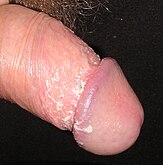Smegma
Smegma (from
Females

The accumulation of
If smegma is not removed frequently it can lead to clitoral adhesion which can make clitoral stimulation (such as masturbation) painful (clitorodynia).[3][4][5][6]
Males

In males, smegma helps keep the glans moist and facilitates sexual intercourse by acting as a lubricant.[7][8][9]
Smegma was originally thought to be produced by sebaceous glands near the frenulum called Tyson's glands; however, subsequent studies have failed to find these glands.[10] Joyce Wright states that smegma is produced from minute microscopic protrusions of the mucosal surface of the foreskin and that living cells constantly grow towards the surface, undergo fatty degeneration, separate off, and form smegma.[7] Parkash et al. found that smegma contains 26.6% fats and 13.3% proteins, which they judged to be consistent with necrotic epithelial debris.[10]
Newly produced smegma has a smooth, moist texture. It is thought to be rich in
According to Wright, the production of smegma, which is low in childhood, increases from adolescence until sexual maturity when the function of smegma for lubrication assumes its full value. From middle-age, production starts to decline and in old age virtually no smegma is produced.[7] Jakob Øster reported that the incidence of smegma increased from 1% among 6- to 9-year-olds to 8% among 14- to 17-year-olds (amongst those who did not present with phimosis and could be examined).[14]
Clinical significance and hygiene
The production of smegma, which increases during puberty, can only be of limited significance, as males and females learn to practice good genital hygiene.[14]
Men with smegma have an elevated risk of developing penile cancer.[15] This is generally thought to be because of irritation caused by smegma, and not by the properties of smegma itself.[15]
Other animals
In healthy animals, smegma helps clean and lubricate the genitals. In veterinary medicine, analysis of this smegma is sometimes used for detection of urogenital tract pathogens, such as
See also
- Keratin pearl
- List of cutaneous conditions
- Mycobacterium smegmatis – found in smegma
References
- ^ "smegma". Merriam-Webster.com Dictionary. Retrieved 2017-03-02.
- ^ "Medical Dictionary". Medilexicon.
- PMID 29559206.
- S2CID 78573467.
- PMID 26104318.
- S2CID 29636705.
- ^ a b c Wright J (September 1970). "How smegma serves the penis: Nature's assurance that the uncircumcised glans penis will function smoothly is provided by smegma". Sexology. 37 (2): 50–53.
- ^
Van Howe RS, Hodges FM (October 2006). "The carcinogenicity of smegma: debunking a myth". Journal of the European Academy of Dermatology and Venereology. 20 (9): 1046–1054. S2CID 22840346.
- ^ a b
Fleiss PM, Hodges FM, Van Howe RS (October 1998). "Immunological functions of the human prepuce". Sexually Transmitted Infections. 74 (5): 364–367. PMID 10195034.
- ^ a b
Parkash S, Jeyakumar S, Subramanyan K, Chaudhuri S (August 1973). "Human subpreputial collection: its nature and formation". Journal of Urology. 110 (2): 211–212. PMID 4722614.
- ^
O'Neill HJ, Gershbein LL (1976). "Lipids of human and equine smegma". Oncology. 33 (4): 161–166. PMID 1018879.
- ^
Frohlich E, Schaumburg-Lever G, Klessen C (1993). "Immunelectron microscopic localization of cathepsin B in human exocrine glands". Journal of Cutaneous Pathology. 20 (1): 54–60. S2CID 1326013.
- ^
Chukwuemeka Anyanwu LJ, Kashibu E, Edwin CP, Mohammad AM (2012). "Microbiology of smegma in boys in Kano, Nigeria". Journal of Surgical Research. 173 (1): 21–25. PMID 21872267.
- ^ a b
Oster J (April 1968). "Further fate of the foreskin. Incidence of preputial adhesions, phimosis, and smegma among Danish schoolboys". Archives of Disease in Childhood. 43 (228): 200–3. PMID 5689532.
The production of smegma increases from the age of 12-13, but our actual figures of the incidence of smegma can only be of limited significance, as the boys received regular instruction about preputial hygiene.
- ^ a b "Risk Factors for Penile Cancer". American Cancer Society. 25 June 2018.
- ^
Chen XG, Li J (2001). "Increasing the sensitivity of PCR detection in bovine preputial smegma spiked with Tritrichomonas foetus by the addition of agar and resin". Parasitology Research. 87 (7): 556–558. S2CID 7671511.
- ^ Primary Industries Ministerial Council of Australia and New Zealand (2002). Disease strategy: Contagious equine metritis Archived 2008-07-21 at the Wayback Machine (Version 1.0). In: Australian Veterinary Emergency Plan (AUSVETPLAN), Edition 3, PIMCANZ, Canberra, ACT.
- ^ Lowder, Michael (1 September 2001). "A Clean Sheath Is A Healthy Sheath". Horse City. Archived from the original on 14 September 2005.
External links
- Neubert, U; Lentze, I (March 1979). "Die bakterielle Flora des Präputialraumes" [The bacterial flora of preputial space]. Hautarzt (in German). 30 (3): 149–153. PMID 35486.
- Marzuillo, Pierluigi; Guarino, Stefano; Furlan, Daniela; Pecoraro, Anna; Pedullà, Marcella; Miraglia del Giudice, Emanuele; La Manna, Angela (October 2018). "Cleaning the genitalia with plain water improves accuracy of urine dipstick in childhood". European Journal of Pediatrics. 177 (10): 1573–1579. S2CID 51726930.
- Fahmy, Mohamed A. Baky (2020). "Smegma". Normal and Abnormal Prepuce. pp. 153–161. S2CID 243171662.
